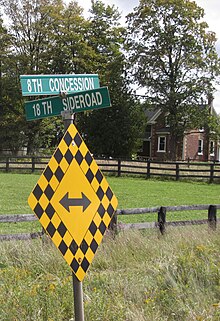This article needs additional citations for verification. (August 2012) |
In Upper and Lower Canada, concession roads were laid out by the colonial government through undeveloped Crown land to provide access to rows of newly surveyed lots intended for farming by new settlers. The land that comprised a row of lots that spanned the entire length of a new township was "conceded" by the Crown for this purpose (hence, a "concession of land"). Title to an unoccupied lot was awarded to an applicant in exchange for raising a house, performing roadwork and land clearance, and monetary payment.[1] Concession roads and cross-cutting sidelines or sideroads were laid out in an orthogonal (rectangular or square) grid plan, often aligned so that concession roads ran (approximately) parallel to the north shore of Lake Ontario, or to the southern boundary line of a county.
Unlike previous American colonial practice, land in Ontario was surveyed first before being allocated to settlers.[2]
The provision of road allowances was an advance over earlier survey systems which allocated no roadways.[3] Waterloo township, for example, had no road allowances.[4]
In some townships, the "line road" name (e.g., Ninth Line) was applied to the roads that elsewhere were called "concession roads", i.e., roads that ran between two adjacent concessions.

- ^ McIlwraith, Thomas R. "Concession line". The Canadian Encyclopedia. Archived from the original on February 3, 2013. Retrieved 29 November 2012.
- ^ Goebelle, Hugh (1997). "The Double-Front Era Township Surveying in Upper Canada (1812 - 1829)" (PDF). krcmar.ca. Archived from the original (PDF) on 2018-02-24. Retrieved 2018-02-23.
- ^ Cite error: The named reference
Hartwas invoked but never defined (see the help page). - ^ Cite error: The named reference
LFOO p61was invoked but never defined (see the help page).
© MMXXIII Rich X Search. We shall prevail. All rights reserved. Rich X Search
